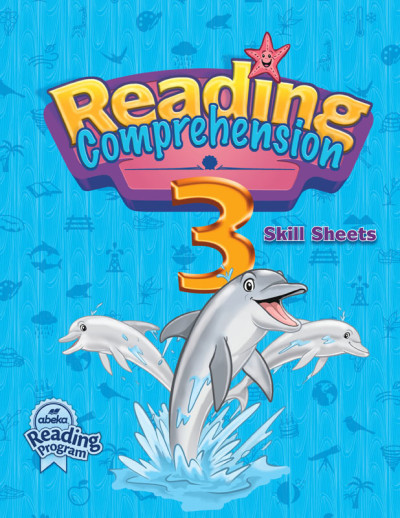We use cookies to make your experience better. To comply with the new e-Privacy directive, we need to ask for your consent to set the cookies. Learn more.
Reading Comprehension 3 Skills Sheets (Bound)
Enhance any reading curriculum with these Abeka® untimed reading skill sheets. Skill sheets encourage student’s growth in fluency and comprehension skills. These 35 readings help students practice reading silently, follow written directions, while they also encourage comprehension skills and an understanding of literary concepts and story moral. The sheets encourage readers to develop critical thinking skills, and practice reading a variety of literature topics and styles. The first selections start at about 200 words and will range to over 300 with paired readings. Typically, students will read a one-page, multi-paragraph writing and then answer comprehension activities and activities that include ordering events, as well as identifying key points and details. Selections include fiction, nonfiction, poetry, instructions, and advertisements. Font size is approximately 13pt with black-line drawings. You’ll need the Parent Edition, item 049337 for answers and additional helps. Non-reproducible. Bound, with perforated pages, pb, 70 pgs. ~ Ruth
Abeka® Reading materials provide distinct benefits. Sets of readers use an all-inclusive and systematic approach to gaining and strengthening reading skills. The literature choices emphasize wholesome, biblically supported content, as well as citizenship and traditional values. Students are provided developmentally appropriate depth and length of reading materials, producing strong readers--early. Skills are built and strengthened with continual practice and review of wholesome content. Using plentiful and colorful readers in the lower grades, students practice word analysis, build vocabulary, and work on developing reading and thinking skills. The program then broadens to include literature and nonfiction, while introducing and practicing literary techniques. Every reading passage comes with a handful of questions to help promote reading comprehension. At each grade level, the number of readers decreases while literature variety increases, and literary skill development strengthens (i.e., Grade 2 uses 10 readers; Grade 6 uses 3).
The Reading answer keys can be found in the Grade level, Answer Key with Literary Development and Enrichment Activities. The answers to all the readers will be included, plus teacher support, story intros, teaching tips, vocabulary enrichment, literary analysis, and more. While the reading programs are part of Abeka's complete language arts curriculum, you can potentially use this program separately to focus solely on reading skills. Materials use KJV scripture.
The K5 program assumes your child has a phonics' base. Then, the multi-sensory approach teaches long vowel, special sounds, beginning/ending blends, digraphs, a few sight words, r-controlled vowels, etc. This level also adds a Primary Bible Reader containing 150 KJV passages from the Old and New Testaments. Grade 1's goal is independent reading: first reviewing phonics, then transitioning to reading skills. The program continues with reviewing phonics instruction, but transitions toward reading skills, aiming at independent reading. A steady development progression begins at Grade 2 (as phonics foundations are mastered). Children learn to read more diverse materials (literature and nonfiction) and begin examining literary techniques such as cause/effect, sequencing, inference, and main character. At any level, assigned readings will include on-page definitions of new vocabulary questions, info about the authors, and "Time to Think" questions at the end (answers in teacher material). Levels from Grade 3 incorporate simplified versions of classic novels. At Grade 4, material steps up in difficulty and genre types. Also starting at this grade, additional optional reading selections provide student analysis and book report possibilities. When students reach Grade 6, they are reading and evaluating a variety of poetry, short stories, excerpts, and adaptations of novels from famous authors.
If you desire, Abeka provides additional tools that can be used alongside this or any reading program. Abeka believes a student's ability to comprehend is based in their ability to concentrate. These additional tools hone such skills at different levels. Grades 2-3 provide Reading Comprehension Skill Sheets, with a Parent Edition (including objectives, enrichment, answers and Bible application). In Grades 4-6, build reading speed and comprehension skills using an Adventures in … reader, along with the consumable Read and Comprehend Skill Sheets. Each separate key provides the student answers. Speed and Comprehension Readers or Skill Sheets provide multiple reading practices: each with a word count and corresponding comprehension quiz. One-page comprehension quizzes are provided for each story. These books include a place to record your student's comprehension and words-per-minute scores. These skill-focused tools are an integral part of Abeka's reading programs. If, however, you're looking for a Christian, systematic approach to consistently check and strengthen speed and comprehension, try using these as independent reading skill tools.
This level continues with the incremental progression that was evident within the Abeka® Grade 2 reading program. Each reader in Grade 3 is designed with specific goals and builds upon the next. Silent reading will be introduced and practiced. Three of the readers are complete narratives, introducing students to continuing stories and chapter books. Books progress in order: From Shore to Shore; My New Song (full narrative); Through the Seasons; Among the Animals; Pilgrim Boy (full narrative); Treats and Treasures; Heroes and Helpers; Secret in the Maple Tree; On the Bright Side; The Swiss Family Robinson (full narrative); Pilgrim's Progress: Christian's Journey (full narrative). You’ll find answers to the comprehension questions in the Reading 3 Answer Key with Literary Development and Enrichment Activities for all-in-one teacher guidance. See the Language Arts 3 Curriculum Homeschool Lesson Plans for additional guidance concerning the reading program.
| Product Format: | Paperback |
|---|---|
| Brand: | A Beka Book |
| Grade: | 3 |
| ISBN: | 9780000315618 |
| Length in Inches: | 11 |
| Width in Inches: | 8.5 |
| Height in Inches: | 0.25 |
| Weight in Pounds: | 0.5 |

